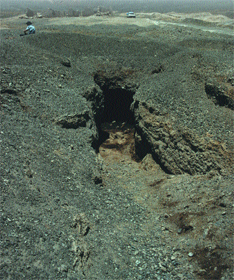 For millennia,
ancient Egyptians used oil tar to preserve bodies. New geologic research shows
that the tar came from several sources, shedding light on how trade routes of
old compare to those of today.
For millennia,
ancient Egyptians used oil tar to preserve bodies. New geologic research shows
that the tar came from several sources, shedding light on how trade routes of
old compare to those of today.New research suggests that ancient Egyptians used oil tar from Gebel Zeit in Egypt, shown here, and from the Dead Sea to preserve mummies. Image courtesy of James Harrell.
All tar sands — crude oils, asphalts and bitumen — contain source-specific compounds, known as biomarkers, which have unique chemical signatures that are closely related to the biological precursors of the oil. Using gas chromatography and mass spectrometers, geologists can identify these biomarkers in the oil to create a very specific “fingerprint” that enables them to trace the location where the oil originated. This fingerprinting is frequently used to trace oil spills to a ship or other point of origin (see Geotimes, January 2005).
Recently, a handful of geologists have fingerprinted tar originating from natural oil seeps around the Middle East and tar samples collected from the 3,000-year-old wraps of mummies. Most have tested mummies that were preserved in tar originating near the Dead Sea, several countries away, close to what is now Israel.
But in 2002, Michael Lewan of the U.S. Geological Survey in Denver, working with colleague James Harrell of the University of Toledo, found one mummy whose tar could be traced to a site called Gebel Zeit (“Oil Mountain” in Arabic) in the Gulf of Suez in Egypt — the first discovery of Egyptian oil having been used in mummy preservation. Following on the heels of this research, Texas A&M University geochemist Chuck Kennicutt, along with colleagues at the University of Alexandria in Egypt and elsewhere, examined the biomarker signatures of several more mummies to see if they could find evidence of mummy tar originating from the same site in Egypt.
Publishing in an upcoming issue of the Journal of Geoarchaeology, Kennicutt’s team reports finding just that. Their new evidence, in combination with the earlier studies showing tar originating from the Dead Sea, thus confirms, they say, that the Egyptians used oil from several sources in embalming their dead. “Our work expands the idea that trade was going on throughout the Middle East in antiquity, much as it is today,” Kennicutt says.
Analyzing more mummies, as well as other items that use oil for a variety of purposes — for example, as a sealant for ceramic pottery and baskets and an adhesive for jewelry — may further illuminate trade and life thousands of years ago, Lewan says. “This is a novel and fascinating application for oil research,” he says.

